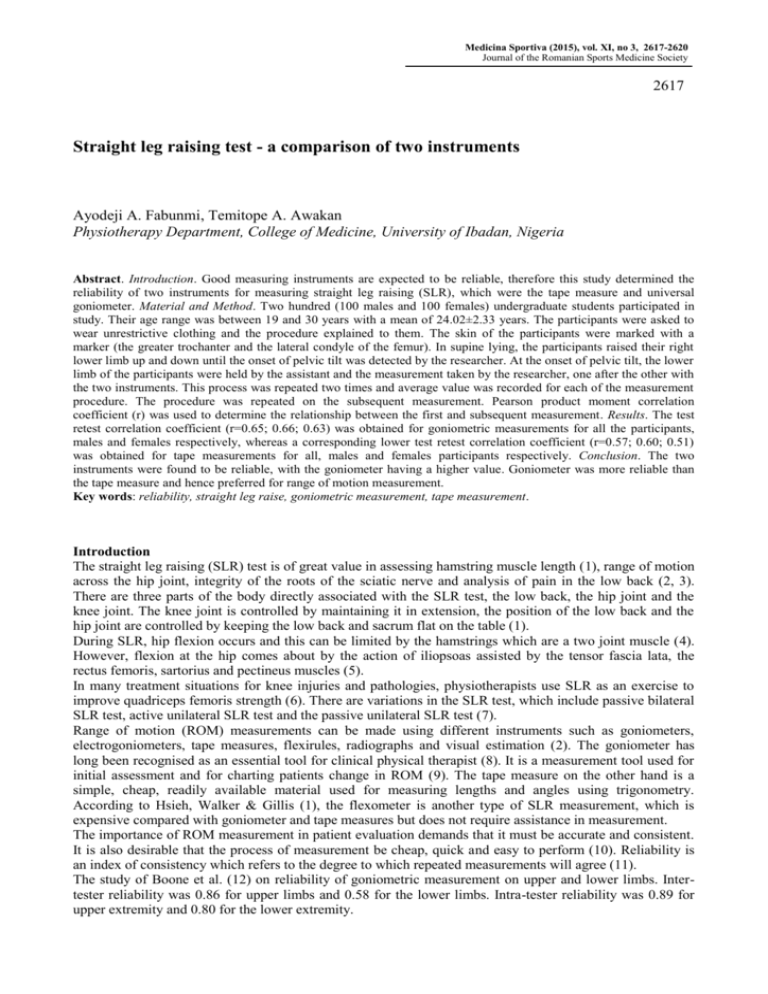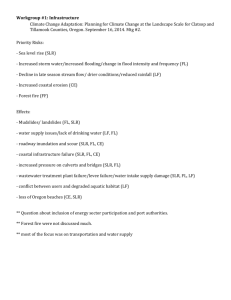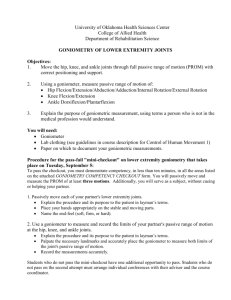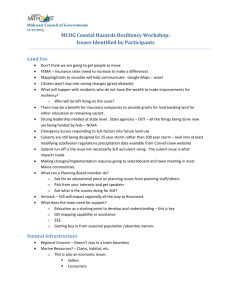Straight leg raising test - a comparison of two instruments
advertisement

Medicina Sportiva (2015), vol. XI, no 3, 2617-2620 Journal of the Romanian Sports Medicine Society 2617 Straight leg raising test - a comparison of two instruments Ayodeji A. Fabunmi, Temitope A. Awakan Physiotherapy Department, College of Medicine, University of Ibadan, Nigeria Abstract. Introduction. Good measuring instruments are expected to be reliable, therefore this study determined the reliability of two instruments for measuring straight leg raising (SLR), which were the tape measure and universal goniometer. Material and Method. Two hundred (100 males and 100 females) undergraduate students participated in study. Their age range was between 19 and 30 years with a mean of 24.02±2.33 years. The participants were asked to wear unrestrictive clothing and the procedure explained to them. The skin of the participants were marked with a marker (the greater trochanter and the lateral condyle of the femur). In supine lying, the participants raised their right lower limb up and down until the onset of pelvic tilt was detected by the researcher. At the onset of pelvic tilt, the lower limb of the participants were held by the assistant and the measurement taken by the researcher, one after the other with the two instruments. This process was repeated two times and average value was recorded for each of the measurement procedure. The procedure was repeated on the subsequent measurement. Pearson product moment correlation coefficient (r) was used to determine the relationship between the first and subsequent measurement. Results. The test retest correlation coefficient (r=0.65; 0.66; 0.63) was obtained for goniometric measurements for all the participants, males and females respectively, whereas a corresponding lower test retest correlation coefficient (r=0.57; 0.60; 0.51) was obtained for tape measurements for all, males and females participants respectively. Conclusion. The two instruments were found to be reliable, with the goniometer having a higher value. Goniometer was more reliable than the tape measure and hence preferred for range of motion measurement. Key words: reliability, straight leg raise, goniometric measurement, tape measurement. Introduction The straight leg raising (SLR) test is of great value in assessing hamstring muscle length (1), range of motion across the hip joint, integrity of the roots of the sciatic nerve and analysis of pain in the low back (2, 3). There are three parts of the body directly associated with the SLR test, the low back, the hip joint and the knee joint. The knee joint is controlled by maintaining it in extension, the position of the low back and the hip joint are controlled by keeping the low back and sacrum flat on the table (1). During SLR, hip flexion occurs and this can be limited by the hamstrings which are a two joint muscle (4). However, flexion at the hip comes about by the action of iliopsoas assisted by the tensor fascia lata, the rectus femoris, sartorius and pectineus muscles (5). In many treatment situations for knee injuries and pathologies, physiotherapists use SLR as an exercise to improve quadriceps femoris strength (6). There are variations in the SLR test, which include passive bilateral SLR test, active unilateral SLR test and the passive unilateral SLR test (7). Range of motion (ROM) measurements can be made using different instruments such as goniometers, electrogoniometers, tape measures, flexirules, radiographs and visual estimation (2). The goniometer has long been recognised as an essential tool for clinical physical therapist (8). It is a measurement tool used for initial assessment and for charting patients change in ROM (9). The tape measure on the other hand is a simple, cheap, readily available material used for measuring lengths and angles using trigonometry. According to Hsieh, Walker & Gillis (1), the flexometer is another type of SLR measurement, which is expensive compared with goniometer and tape measures but does not require assistance in measurement. The importance of ROM measurement in patient evaluation demands that it must be accurate and consistent. It is also desirable that the process of measurement be cheap, quick and easy to perform (10). Reliability is an index of consistency which refers to the degree to which repeated measurements will agree (11). The study of Boone et al. (12) on reliability of goniometric measurement on upper and lower limbs. Intertester reliability was 0.86 for upper limbs and 0.58 for the lower limbs. Intra-tester reliability was 0.89 for upper extremity and 0.80 for the lower extremity. Straight leg raising test - a comparison of two instruments Ayodeji A. Fabunmi & all 2618 These findings emphasized the necessity for using the same tester for joint motion measurements and that one measurement per measurement session is as reliable as taking the average of repeated measurement in a session. Petherick et al. (8) showed that while measuring active elbow ROM the goniometer showed poor inter-tester reliability of 0.53 compared with the fluid base goniometer which had a high inter-tester reliability (r) of 0.92. The aim of this study was to determine the reliability of the use of the goniometer and tape measure in assessment of straight leg raising. Material and Method Ethical principles and guidelines as recommended from Declaration of Helsinki, Finland, June 1966 were strictly adhered to in this study. The procedure was adequately explained to the participants and their informed consent was sought and obtained before being allowed to participate in this study. This research is an ex-post facto design. The participants were clinical students of the University of Ibadan, resident in Alexander Brown hall, University College Hospital. They were seen two times with a three day period in between for measurements. The participants were selected and allowed to participate in this study as they are available. Two hundred (100 males and 100 females) undergraduate students were eventually selected to participate in this study. Only students that gave consent participated in the study. All measurements were done at the outpatient unit of the physiotherapy department. Instruments 1. Height meter: a detachable plastic height meter (Invieta plastic limited England), calibrated in centimeters (cm) from 0-207cm with an adjustable horizontal bar. The height of the participants was measured in centimeters. 2. Weighing scale: a bathroom scale, made by (Hanson limited Ireland) was used to measure the weight of the participants to the nearest kilogram (kg) from 0-150kg. 3. A full circle plastic goniometer: consisting of one stationary arm and one movable arm was used. The stationery arm was 18 cm long and the movable arm was 30 cm long. It was used to measure the angle of hip flexion obtained during straight leg raise. All measurements were taken to the nearest degree. 4. An inelastic tape measure (Butterfly Brand): which was 0-150cm in length was used to measure the distance between the greater trochanter and the lateral femoral condyle of each participant of the right lower limb. 5. A wooden plinth was used to position all participants in supine lying. 6. A skin marker was used to mark the reference points on the body of the participants. Measurement Procedure. The age of each participant was recorded in years as age as at last birthday. The gender of the participants was recorded as M for male and F for female. Height was measured using the height meter. The participants stood on the height scale platform without footwear, looking straight ahead, leaning against the height meter, which was placed against the wall. The knees extended and kept straight, upper limbs by their sides, and then the height was taken and recorded in centimeters. Body weight was measured using the bathroom weighing scale. The participants stood on the scale bare footed, and then looking straight ahead their weight was taken and recorded in the nearest kilograms (kg). Goniometric Measurement: Hip flexion in SLR was measured only on right side at the limit of the SLR. The participants assumed supine lying position on the plinth, close to the side of the plinth where measurement is to be taken. The goniometer was placed with the stationary arm along the lateral midline of the right thigh, and the axis over the superior half of the greater trochanter. Tape Measure: Three distances were measured as shown in diagram below: A) the distance between the anterosuperior margin of the greater trochanter and the lateral femoral epicondyle, B) the distance between lateral femoral epicondyle and the ground, and C) the distance between the anterosuperior margin of the greater trochanter and the ground. The lateral femoral epicondyle was selected to avoid influence of knee position on the measurement. The hip flexion angle ɵ was calculated with the formulae below. Data Analysis. All variables measured were analysed with descriptive statistics of mean, range and standard deviation. Inferential statistics of Pearson product moment correlation coefficient was used to determine the relationship between first and second measurement of ROM for goniometer and tape measure. Medicina Sportiva Straight leg raising test - a comparison of two instruments Ayodeji A. Fabunmi & all 2619 ɵ = sin -1 (B - C)/A Figure 1. Position of participant in tape measurement method (2) Results The results of the research are showed below (table I-III). Table I. Physical characteristics of subjects Age (years) Subjects Weight (Kg) Height (m) Range Mean±SD Range Mean±SD Range Mean±SD All subjects (N=200) 19.00-30.00 24.02±2.33 40.00-95.00 62.84±8.82 105.00-188.00 165.62±8.7 Males (N=100) 19.00-30.00 24.36±2.38 48.00-95.00 66.36±9.02 153.00-188.00 168.90±7.56 Females (N=100) 19.00-30.00 23.68±2.23 40.00-75.00 59.32±7.06 105.00-179.00 162.36±8.64 Table II. Goniometric and Tape measurement for straight leg raising (SLR) 1st Reading Parameters 2nd Reading Range Mean±SD Range Mean±SD All subjects (N=200) 5.00-51.00 28.93±6.23 8.40-50.00 29.00±5.94 Males (N=100) 5.00-51.00 29.93±6.58 8.40-50.00 29.57±6.15 Females (N=100) 18.00-40.00 27.93±5.71 17.50-46.10 28.43±5.69 All subjects (N=200) 32.00-54.00 41.96±5.51 31.30-59.00 42.06±4.54 Males (N=100) 32.00-53.60 42.84±4.41 31.30-59.00 42.93±4.79 Females (N=100) 32.00-54.00 41.09±4.45 35.00-53.00 41.19±4.12 Tape measurement Goniometric measurement Table III. Intra- rater test-retest relationship of goniometric and tape measurements Subjects All participants Males Females Tape measure 0.57 0.60 0.51 p- value 0.00 0.00 0.00 Goniometer 0.65 0.66 0.63 p- value 0.00 0.00 0.00 Discussion Tanigawa (13) and Erickson and Coney (14) had claimed that goniometric measurement of SLR was not accurate. Goniometric measurements has been found to be reliable in measurement of joint ROM in different joints in the body (15). However the same goniometric measurement of SLR was found to be reliable (16). The result of this study confirmed reports that goniometric method of measurement of ROM in SLR was reliable (1, 16). The tape measurement method was also found to be reliable in this study which agrees with Medicina Sportiva Straight leg raising test - a comparison of two instruments Ayodeji A. Fabunmi & all 2620 Hsieh, Walker and Gillis, (2). The goniometric measurement reliability 0.53-0.65 obtained by Hayes et al (17), for shoulder range of motion is quite comparable to the reliability of 0.63-0.66 obtained for SLR. The result of this study showed that goniometric method of SLR measurement was more reliable than the tape measurement method was in agreement with the outcome of Hsieh, Walker and Gillis (2). Both methods of measurement of SLR require assistance. The tape measure involves calculation with trigonometry which makes it cumbersome to be used is a very busy department. Conclusion The goniometer and tape measure (trigonometry) are both reliable instruments in assessment of SLR but goniometer is more reliable for measurement. For clinicians the goniometer is easier to use since it does not involve mathematical calculation as in tape measure which a busy physiotherapist may not have time to perform. References 1. Kendall FP, Mc Creary EK (1993). Muscles: testing and function. 4th ed. Baltimore. Williams and Wilkins. pp 214-229. 2. Hsieh CY, Walker JM, Gillis K (1983). The straight leg raising test: Comparison of three instruments. Physical Therapy; 63: 1429-1433. 3. Boland RA, Adams RD (2000). Effects of ankle dorsiflexion on range and reliability of straight leg raise. Australian Journal of Physiotherapy; 46: 191-200. 4. Bohannon RW (1982). Cinematographic analysis of the passive straight leg raising test for hamstrings muscle length. Physical Therapy; 62: 1269-1274. 5. Smith LK, Weiss EL, Lehmkuhl LD (1988). Brunnstrom’s clinical kinesiology. 5th ed. Philadelphia. F. A. Davies Co. 290-291. 6. Soderberg GL, Cook TM (1983). An electromyographic analysis of quadriceps femoris muscle setting and straight leg raising. Physical Therapy; 63: 1434-1438. 7. Gajdosik R, Lusin G (1983). Hamstring muscle tightness. Physical Therapy; 63: 1085- 1088. 8. Petherick M, Rheault W, Kimble S, Lechner C, Senear V (1988). Concurrent validity and intertester reliability of universal and fluid based goniometers for active elbow range of motion. Physical Therapy; 68(6): 966-969. 9. Rothstein MJ, Miller PJ, Roettger RF (1983). Goniometric reliability in a clinical setting. Physical Therapy; 63(10): 1611-1615. 10. Williams JG, Callaghan M (1990). Comparison of visual estimation and goniometry in determination of a shoulder joint angle. Physiotherapy; 76(10): 655-657. 11. Currier PD (1981). Elements of Research in Physical Therapy. Baltimore. Williams and Willkins. Pp 152-158. 12. Boone DC, Azen SP, Lin CM, Spence C, Baron C, Lee L (1978). Reliability of goniometric measurements. Physical Therapy; 58(11): 1355-1360. 13. Tanigawa MC (1972). Comparison of the hold relax procedure and passive mobilization on increasing muscle length. Physical Therapy; 52(7): 725-735. 14. Erickson K, Coney C (1979). The effectiveness of release mechanisms on tight hamstrings. Hold-relax, repeated contractions and hamstring squat release Unpublished paper. Department of Physical Therapy, University of Southern California. 15. Watkins MA, Riddle DL, Lamb RL, Personius WJ (1991). Reliability of Goniometric measurements and Visual Estimates of knee range of Motion obtained in a clinical setting. Physical Therapy; 71(2): 90-96. 16. Troup JDG, Hood CA, Chapman AE (1968). Measurement Of the sagittal mobility of the lumbar spine and hips. Rheumatology; 9(8): 308-321. 17. Hayes K, Walton JR, Szomor ZL, Murrel GAC (2001). Reliability of five methods for assessing shoulder range of motion. Australian Journal of Physiotherapy; 47(4): 289-294. Corresponding Author Fabunmi Ayodeji Ayodele Physiotherapy Department, College of Medicine University of Ibadan, Nigeria. E-mail: aafabunmi@yahoo.com Phone: +234-803-373-1812 Received: July 07, 2015 Accepted: August 25, 2015 Medicina Sportiva









